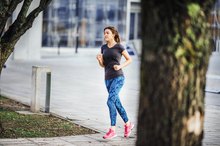What Is the Purpose of Pursed Lip Breathing?
Pursed lip breathing, or PLB -- exhaling through tightly pressed, pursed lips -- is an instinctive response by some people with chronic obstructive pulmonary disease, commonly called COPD, simply because it makes breathing easier. Doctors and respiratory therapists teach the technique to their patients to ease shortness of breath and make exercise more tolerable.
If you are experiencing serious medical symptoms, seek emergency treatment immediately.
Opening Airways
You exhale by making your lungs smaller to push air out. But this narrows air passages inside your lungs. In COPD, your airways are always partly obstructed, so every exhalation worsens the difficulty of moving air, making it much harder than inhaling. This also prolongs exhalation and delays the next full breath.
The purpose of PLB is to create back-pressure inside your airways to splint them open. Moving air then takes less work.
- You exhale by making your lungs smaller to push air out.
- But this narrows air passages inside your lungs.
Improving Lung Mechanics
Breathing Exercises That Increase Metabolism
Learn More
Pursed lip breathing improves the mechanics of breathing for COPD patients 1. According to a 2007 report in the "Journal of Cardiopulmonary Rehabilitation & Prevention," narrowing airways in COPD progressively trap more air inside your lungs over many years 1. This raises your ribs toward maximal inhalation, held shoulders high and diaphragm downward. Deep breaths become nearly impossible, and breathing becomes exhausting.
One purpose of PLB is to improve exhalation. This relieves some strain on over-stretched chest muscles and some work of breathing, and returns the inhalation-to-exhalation ratio toward a normal 1:2.
- Pursed lip breathing improves the mechanics of breathing for COPD patients 1.
- This relieves some strain on over-stretched chest muscles and some work of breathing, and returns the inhalation-to-exhalation ratio toward a normal 1:2.
Exchanging Air
At the end of normal exhalation, some stale air always stays inside your lungs. But in COPD that residual volume of stale air is even larger than normal. Every breath of fresh air is diluted into this reservoir of used air. The larger that reservoir, the less inefficient your air exchange.
Because PLB widens airways, you can exhale more stale air with every breath, and inhale more new, fresh air. Pursed lip breathing increases efficiency of air exchange and enhances exercise tolerance.
- At the end of normal exhalation, some stale air always stays inside your lungs.
Blood Gas Exchange
How the Heart & Lungs Work During Exercise
Learn More
Inhaled air delivers oxygen to your lungs for transfer into your blood. At the same time, carbon dioxide leaves your blood and enters your lungs to be exhaled. The large reservoir of trapped air in COPD accumulates carbon dioxide and is depleted of oxygen. The fresh air you can inhale is insufficient to replenish the oxygen or flush out excess carbon dioxide. Pursed lip breathing helps your lungs exchange oxygen and carbon dioxide better to help maintain the vital balance of blood gases.
- Inhaled air delivers oxygen to your lungs for transfer into your blood.
- At the same time, carbon dioxide leaves your blood and enters your lungs to be exhaled.
Shortness of Breath
Shortness of breath is usually the biggest complaint of patients with COPD. Pursed lip breathing may be your easiest relief for shortness of breath, according to doctors at the Cleveland Clinic. By allowing a more complete exhalation, PLB helps you relieve yourself of some stale air trapped in your lungs. Your breathing muscles, including neck and shoulders, diaphragm and rib cage, send fewer strain signals to your brain, contributing less to a sensation of breathing difficulty. Along with better oxygen and carbon dioxide levels, these factors all work together in PLB to relieve shortness of breath.
- Shortness of breath is usually the biggest complaint of patients with COPD.
- Your breathing muscles, including neck and shoulders, diaphragm and rib cage, send fewer strain signals to your brain, contributing less to a sensation of breathing difficulty.
Related Articles
References
- Journal Of Cardiopulmonary Rehabilitation: Physiology of pursed lip breathing
- Breathing Exercises. American Lung Association. June 27, 2019
- Yohannes AM, Junkes-cunha M, Smith J, Vestbo J. Management of Dyspnea and Anxiety in Chronic Obstructive Pulmonary Disease: A Critical Review. J Am Med Dir Assoc. 2017;18(12):1096.e1-1096.e17. doi:10.1016/j.jamda.2017.09.007
- Fahy JV, Dickey BF. Airway mucus function and dysfunction. N Engl J Med. 2010;363(23):2233–2247. doi:10.1056/NEJMra0910061
- COPD: Clearing Your Lungs. University of Wisconsin. School of Medicine and Public Health. Health Information. June 9, 2019
- American Lung Institute. Breathing Exercises. June 27, 2019.
- COPD Foundation. Breathing Exercises.
- Dahler A, Matthes M, Keszei A, et.al. Characterization and Triggers of Dyspnea in Patients with Chronic Obstructive Pulmonary Disease or Chronic Heart Failure: Effects of Weather and Environment. Lung. 2019 Feb;197(1):21-28. doi:10.1007/s00408-018-0170-2
- Lung Institute. Breathing Exercises for COPD. Apr 11, 2017.
- University of Wisconsin-Madison School of Medicine and Public Health. COPD: Clearing Your Lungs. Sept 5, 2018.
Writer Bio
Walt Pickut has published peer-reviewed medical research since 1971. Pickut teaches presentational speaking and holds board registries in respiratory care and sleep technology. He is a member of the Society of Professional Journalists and the American Society of Business Publication Editors and is editor for "The Jamestown Gazette." Pickut holds bachelor's degrees in biology and communication, and master's degrees in physiology and mass communication.









